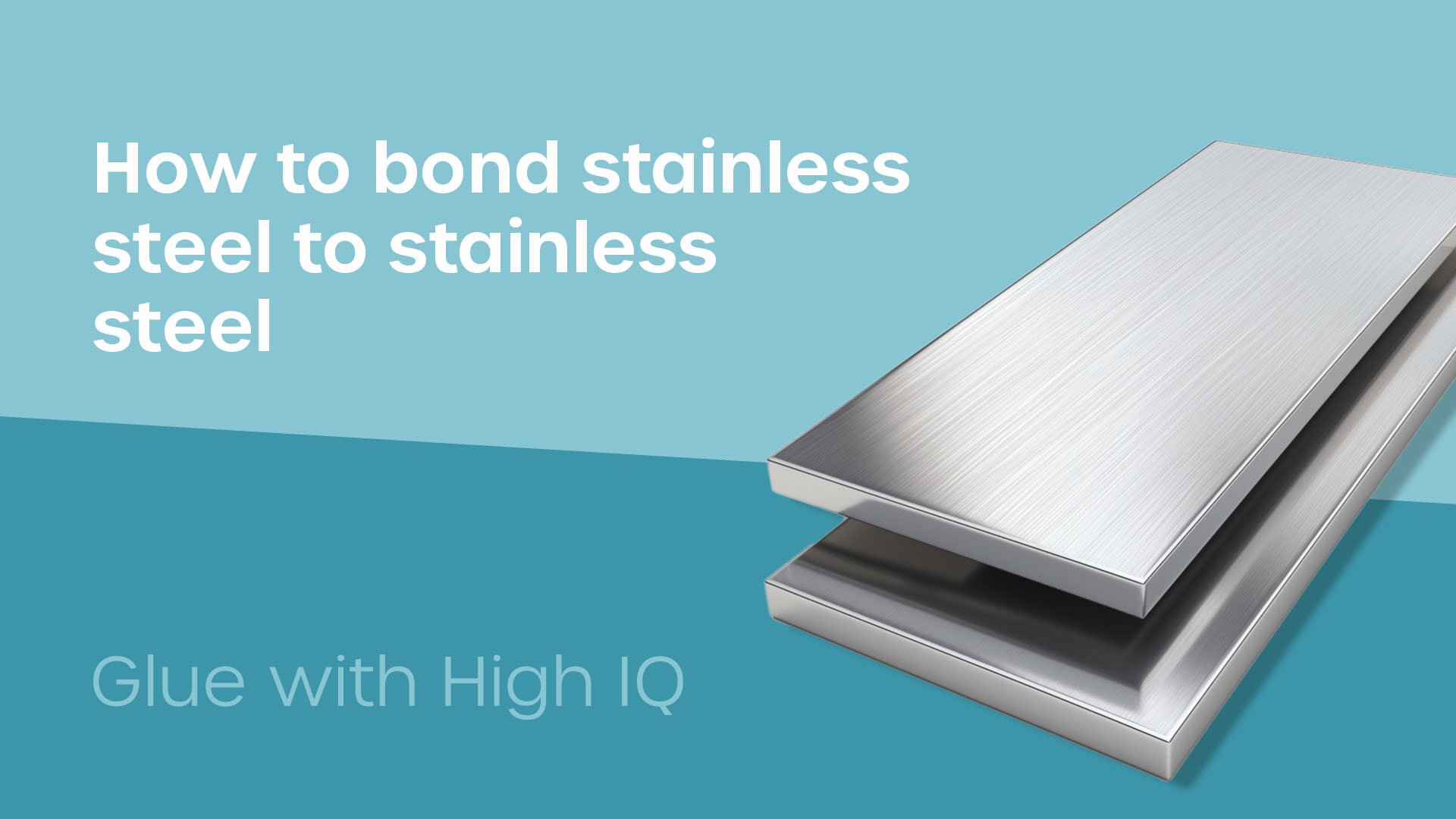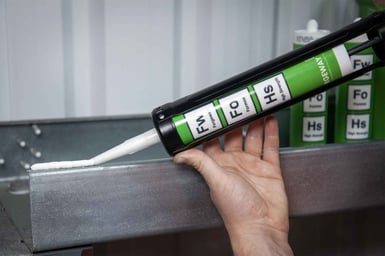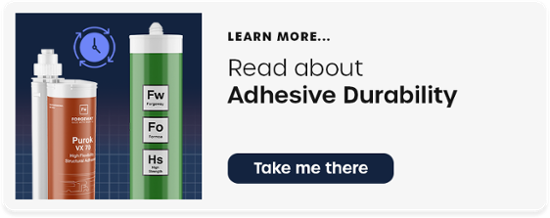Bonding Stainless Steel to Stainless Steel Tips, Tricks, and Considerations for a strong bond

In an era of new materials and breakthrough developments, not much can beat the stability of a tried and trusted material. Stainless steel is still one of the most popular and common materials for industrial manufacturers. But what about when it comes to bonding stainless steel?
This question frequently comes across our desks here at Forgeway. We manufacture industrial adhesives. Our customers often ask us for stainless steel adhesive solutions.
You’re already at the point where you want to use adhesives to join stainless steel. You want to establish the best way to bond stainless steel without welding or using mechanical fasteners.
This article will explain just that. We’ll analyse what you must consider before bonding the metal. Then we’ll discuss what makes a strong and durable bond. By the end of the article, you’ll be an adhesive expert who knows what to consider before bonding stainless steel to stainless steel.
You can also see the video below of a bus manufacturer using Forgeway’s glue to bond Stainless Steel side panels on their vehicle.
Is stainless steel difficult to bond?
Because of stainless steel’s popularity, it will often require joining structures or vehicles. You’ve ruled out using other joining methods such as welding or mechanical fasteners. You are determined to take advantage of the low cost and relative ease that comes with using adhesives.
Now, there’s one question that you aren’t sure about; is Stainless Steel difficult to bond?
And the answer is “Not really“. Which may seem vague on the surface. But let’s dive deeper into that answer and explain why.
Usually, you will have no abnormal difficulties bonding stainless steel. Just like aluminium or other non-coated metals, it may require light abrasion to improve adhesion. But typically, it will present no bonding challenges.
Here comes the ‘however’…
However, some grades and variations of stainless steel can cause bonding challenges. Highly polished grades of the material can cause bonding challenges. The lack of ‘roughness’ of the surface reduces the amount of surface area for the adhesive to bond onto.

The easy fix for this problem is to take the surface preparation to the next level. Grit blasting, sanding or even laser treatment are methods to improve the adhesion. The hardness of stainless steel often provides difficulty with abrasion and ablation though.
And, if you require the polished look for aesthetic purposes, you’ll need to control the surface preparation to small bonding areas.
The other potential issue that can arise with stainless steel is variants with increased chromium levels. Some grades can have added chromium to enhance the corrosion resistance.
Although uncommon, this increased chromium content can affect the adhesion between the material and the adhesive. This may require the use of a primer or adhesion promoters to ensure a strong bond.
Not properly addressing these initial concerns can result in premature bond failure. It’s unlikely that stainless steel will cause bonding challenges. It is usually an easy material to bond.
Nonetheless, it’s wise to test your specific grade of stainless steel before you can be confident it won’t present bonding challenges. If you need help with testing materials for adhesion, watch the video below or get in touch with a member of the Forgeway team.

What you must consider before bonding stainless steel
Now that you understand a bit more about stainless steel’s compatibility with adhesives, it’s time to understand your needs. After all, your application will be different to other stainless steel bonding applications.
So what do you need to consider when bonding stainless steel?
There are five main factors you must consider:

We also recommend considering the factors in that order. Price should never come before a strong bond. Particularly for applications that are critical to safety. But it’s still a consideration all the same.
Why is surface compatibility important?
As we described above, some grades of stainless steel can be difficult to bond. But it’s not just about the stainless steel. If you’re also joining other materials to the stainless steel, you’ll need to ensure that the other material is also compatible with adhesives.
Some plastics (like polypropylene) and some coated metals (like galvanised steel) are notorious for causing bonding challenges. If you’re bonding the stainless steel to these materials, it’s essential to carry out testing to ensure they form strong bonds.
Watch the video below to figure out how you can be sure of the bondability of your material(s).
How do manufacturing constraints affect adhesive selection?
Oddly enough, manufacturing constraints can often dictate a company’s adhesive choice. They don’t just affect adhesive selection, manufacturing requirements can be the reason for choosing one adhesive over another.
This is strange because the manufacturing process is such a small part of the adhesive’s lifecycle. Nonetheless, an adhesive that causes as little disruption to the production of a product as possible will help minimise the chance of error.
Operator error is responsible for over 90% of bond failures. So this part is essential to get right.
Characteristics like cure time, ease of use and toxicity are all factors to consider when analysing an adhesive’s impact on production.

Faster-curing adhesives are often more popular due to the perceived benefit to production throughput. Open time and fixture time are particularly important considerations.
A fast-curing adhesive doesn’t leave a lot of time for operators to put the stainless steel in the right place. Fixture time will dictate how quickly you can put the bonded joint into light operation to move on to the next stage of production.
Two-component (2K) adhesives can be more difficult to use as the operator must ensure the two components mix correctly to ensure maximum performance. However, some single-component (1K) adhesives can be difficult to gun out due to the thickness (viscosity).
And, of course, toxicity. You’ll be well aware that some chemicals can be harmful to humans. Sometimes, adhesives can contain these harmful chemicals.
Polyurethane adhesives contain diisocyanates which now face restrictions in certain regions around the world. (Watch the video below to discover more about the effect of diisocyanates).
So, whilst you may not have considered it before, you’ll now realise that manufacturing requirements can have a significant impact on the adhesive you choose. It’s important to understand what manufacturing requirements you’ll need from an adhesive before you choose it.
Why will the end application determine what adhesive you use?
Each application is different. You could be using stainless steel for the side panels of a bus. You could be using stainless steel components on a yacht, or a plane, or any other vehicle.
The point is; no two applications are the same. So that’s why it’s essential to analyse what characteristics your adhesive must have to ensure the durability of bonded stainless steel joints. There is no ‘Best glue for bonding stainless steel’.
Typically, you’ll need a structural adhesive for bonding stainless steel. However, you can also use semi-structural hybrid polymer adhesives which are particularly useful when you need a high-strength multipurpose adhesive sealant.

But it’s not just about strength. Yes, a strong adhesive helps. But it doesn’t tell you how durable that adhesive will be in robust situations, harsh environmental conditions or abnormal temperatures.
Most people don’t realise that flexibility is just as important as strength in bonding applications that will experience movements.
We’ve written in length about what you need to consider when selecting an adhesive. The adhesive is the most important part of the bond. If the adhesive isn’t up for the task, it doesn’t bode well for the bonded joint.
So make sure to do your research and understand what you need from your adhesive before you select it. Click on the button below to read more about these considerations.
Why is joint design important for permanent stainless steel adhesion?
After adhesive selection, joint design is the second most important part of a strong bond.
You can’t just switch away from a different joining method like welding or mechanical fasteners. The adhesive will not have optimum performance unless you enhance the joint design.
Joint design is an art. The many factors of a successful bond must be designed perfectly to optimise performance while meeting aesthetic requirements in certain applications. That’s why we dedicated a whole chapter to this topic in the Fundamentals of Adhesive eBook.
But in summary, there are two essential parts to a strong joint:
- Maximising adhesive surface area
- Minimising peel and cleavage force

Maximising the surface area of the adhesive will increase the amount of interaction between the adhesive and the stainless steel. It increases the strength of the joint.
Adhesive joints are famously susceptible to peel and cleavage forces. These forces put stress on focussed parts of the adhesive rather than spreading the stress evenly.
If you want to significantly increase the bond’s likelihood of success, you’ll do all you can to minimise the exposure to peel and cleavage forces. We recommend reading Chapter 6 of the eBook to view some common examples of methods to reduce peel and cleavage force.
Is price an important adhesive consideration?
You’ve probably reached this point and thought, “Surely there are no more considerations?” Well, you’re wrong. Price is still the most important consideration for some companies.
In the grand scheme of things, the cost of the adhesive is such a small part of the overall project. Yet cost seems to dictate much of the conversation.
So understanding that there are some adhesive chemistries with significantly lower cost can help determine which product you want to go for. You’ll also pay for brand names in the adhesive industry.
Some adhesive manufacturers can charge more just for the branding on the tube. But you should remember that it’s not just about the cost of the adhesive itself.
Ease of storage, technical support and training are all things to consider when analysing the cost of an adhesive solution.
Ensuring a strong joint when bonding stainless steel to stainless steel
As you will have learned by now, a strong stainless steel bonded joint is not just about the adhesive. There are countless factors to consider that determine a successful bond.
After reading this article, you’ll have a very good idea of what you need to do to get a strong and durable bond. Nonetheless, you might still not have the answer you’re looking for.
Here at Forgeway, we have solved countless stainless steel bonding challenges. We manufacture a range of adhesives for industrial manufacturers just like you.
If you still want help with your stainless steel application, you can reach out to a member of the Forgeway team. They will help you solve your exact bonding challenge.
Or, if you’re the independent type and you want to research the solution yourself, you can fill in the product selector quiz below. It will ask you a range of questions and recommend an adhesive type based on your input.
You’re just 45 seconds away from a personalised solution!
Thomas is the Content Manager here at Forgeway. Thomas' job is to translate the technical jargon from the ivory tower of academia into easy-to-read content that everyone can understand. Forgeway's mission is to answer every question our customers and prospective clients ask, or are apprehensive to ask.





